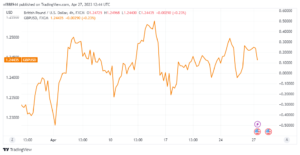After an unsuccessful effort to breach over 1.2500, the GBPUSD has lost traction.
After climbing a few pips over 1.2500 in the early American session on Wednesday, GBPUSD has returned below that level early Thursday. Buyers appear to have shifted to the sidelines ahead of the highly anticipated US GDP statistics. But the technical view implies that the bullish bias will remain in place in the short run.
Midweek, risk perception continued to drive the US Dollar’s valuation. Following a more than 1% increase in the Nasdaq Composite Index on Wednesday. The US Dollar Index (DXY) dropped dramatically, allowing GBPUSD to reach 1.2500. As the Dow Jones Industrial Average and the S&P 500 failed to remain in positive territory later in the day. The DXY managed to recoup some of its daily losses.
In European trading hours, US stock index futures are up between 0.3% and 0.8%, indicating another bullish start on Wall Street. Nonetheless, the US Bureau of Economic Analysis’ preliminary estimate of first-quarter real GDP growth might influence GBPUSD movement in the early American session.
The US economy is expected to expand by 2% on an annualized basis in Q1. If statistics show a more severe downturn in activity than predicted, markets may begin pricing in more than one 25 basis point Federal Reserve (Fed) rate decrease later this year. In that case, the USD is expected to drop more versus its key competitors.
GBPUSD Technical Analysis
On the other side, a positive GDP figure of about 2.5% might spark a rally. The DXY will rebound, forcing the GBPUSD to fall. If US stocks welcome the outcome, the pair’s losses may be limited.

GBPUSD is trading above the 1.2440/1.2450 support level, which contains the four-hour chart’s 20-, 50-, and 100-period Simple Moving Averages. Furthermore, despite the recent downturn, the Relative Strength Index (RSI) indicator remains above 50, maintaining the bullish bias.
On the upswing, 1.2500 (static level, psychological level) serves as the first resistance level before 1.2550 (uptrend end-point) and 1.2600 (psychological level).
On the downside, a four-hour closing below 1.2440/1.2450 might signal the start of a longer-term decline towards 1.2400 (psychological threshold, static level) and 1.2350 (200-period SMA).









